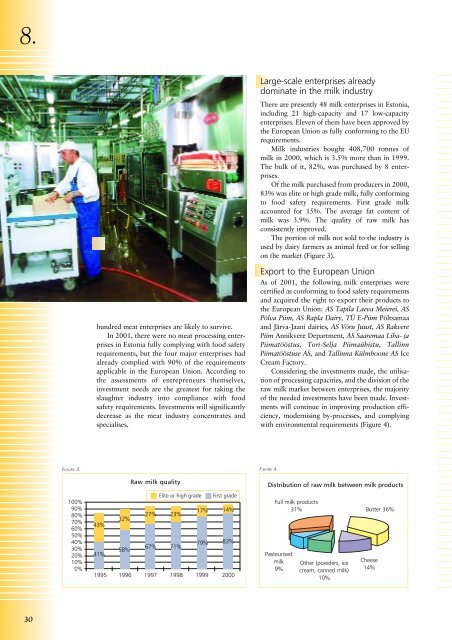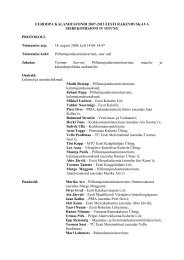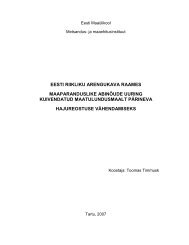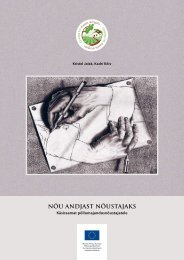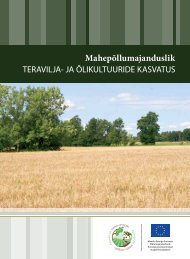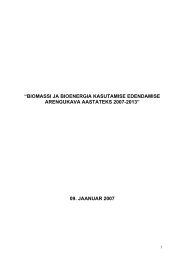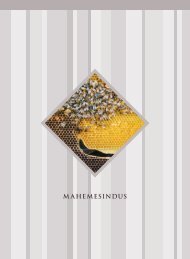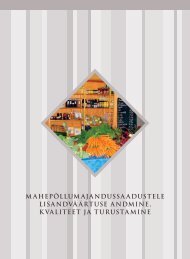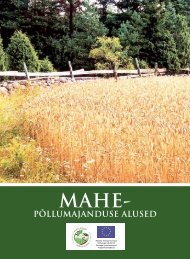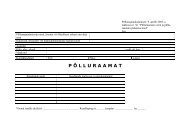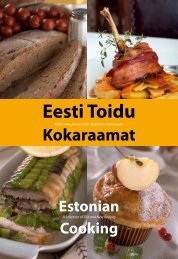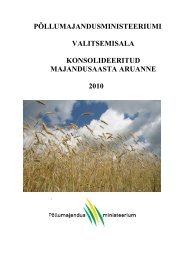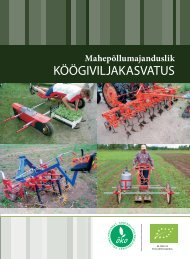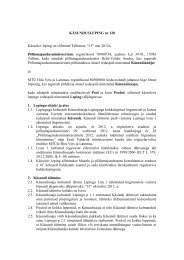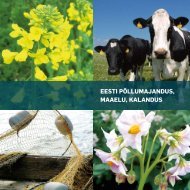estonian agriculture, rural economy and food industry
estonian agriculture, rural economy and food industry
estonian agriculture, rural economy and food industry
Create successful ePaper yourself
Turn your PDF publications into a flip-book with our unique Google optimized e-Paper software.
8.<br />
hundred meat enterprises are likely to survive.<br />
In 2001, there were no meat processing enterprises<br />
in Estonia fully complying with <strong>food</strong> safety<br />
requirements, but the four major enterprises had<br />
already complied with 90% of the requirements<br />
applicable in the European Union. According to<br />
the assessments of entrepreneurs themselves,<br />
investment needs are the greatest for taking the<br />
slaughter <strong>industry</strong> into compliance with <strong>food</strong><br />
safety requirements. Investments will significantly<br />
decrease as the meat <strong>industry</strong> concentrates <strong>and</strong><br />
specialises.<br />
Large-scale enterprises already<br />
dominate in the milk <strong>industry</strong><br />
There are presently 48 milk enterprises in Estonia,<br />
including 21 high-capacity <strong>and</strong> 17 low-capacity<br />
enterprises. Eleven of them have been approved by<br />
the European Union as fully conforming to the EU<br />
requirements.<br />
Milk industries bought 408,700 tonnes of<br />
milk in 2000, which is 3.5% more than in 1999.<br />
The bulk of it, 82%, was purchased by 8 enterprises.<br />
Of the milk purchased from producers in 2000,<br />
83% was elite or high grade milk, fully conforming<br />
to <strong>food</strong> safety requirements. First grade milk<br />
accounted for 15%. The average fat content of<br />
milk was 3.9%. The quality of raw milk has<br />
consistently improved.<br />
The portion of milk not sold to the <strong>industry</strong> is<br />
used by dairy farmers as animal feed or for selling<br />
on the market (Figure 3).<br />
Export to the European Union<br />
As of 2001, the following milk enterprises were<br />
certified as conforming to <strong>food</strong> safety requirements<br />
<strong>and</strong> acquired the right to export their products to<br />
the European Union: AS Tapila Laeva Meierei, AS<br />
Põlva Piim, AS Rapla Dairy, TÜ E-Piim Põltsamaa<br />
<strong>and</strong> Järva-Jaani dairies, AS Võru Juust, AS Rakvere<br />
Piim Annikvere Department, AS Saaremaa Liha- ja<br />
Piimatööstus, Tori-Selja Piimaühistu, Tallinn<br />
Piimatööstuse AS, <strong>and</strong> Tallinna Külmhoone AS Ice<br />
Cream Factory.<br />
Considering the investments made, the utilisation<br />
of processing capacities, <strong>and</strong> the division of the<br />
raw milk market between enterprises, the majority<br />
of the needed investments have been made. Investments<br />
will continue in improving production efficiency,<br />
modernising by-processes, <strong>and</strong> complying<br />
with environmental requirements (Figure 4).<br />
FIGURE 3.<br />
FIGURE 4.<br />
Raw milk quality<br />
Distribution of raw milk between milk products<br />
100%<br />
90%<br />
80%<br />
70%<br />
60%<br />
50%<br />
40%<br />
30%<br />
20%<br />
10%<br />
0%<br />
43%<br />
41%<br />
1995<br />
Elite or high grade First grade<br />
17% 14%<br />
27% 23%<br />
32%<br />
79% 83%<br />
67% 71%<br />
58%<br />
1996 1997 1998 1999 2000<br />
Full milk products<br />
31%<br />
Pasteurised<br />
milk<br />
9%<br />
Other (powders, ice<br />
cream, canned milk)<br />
10%<br />
Butter 36%<br />
Cheese<br />
14%<br />
30


